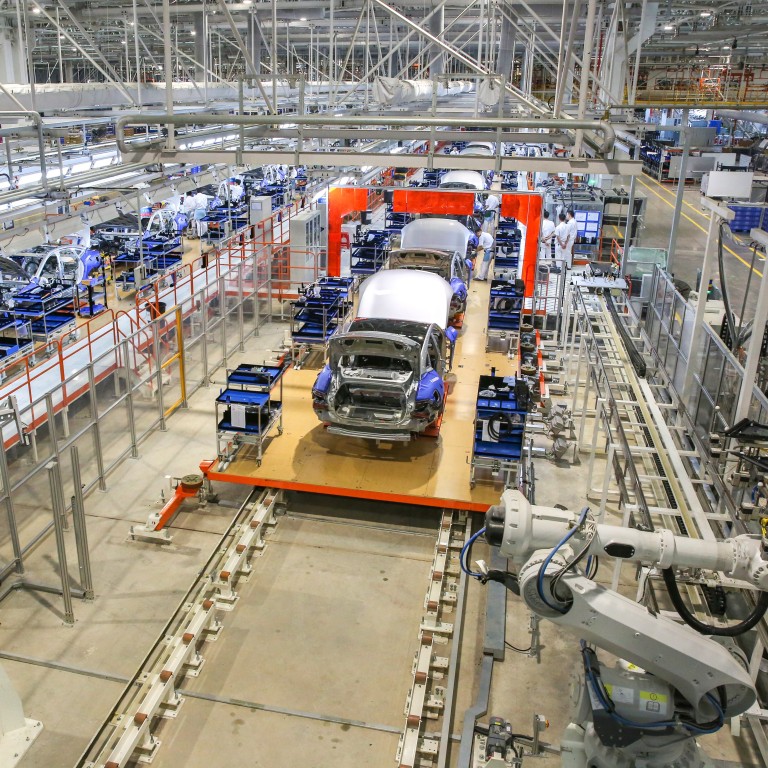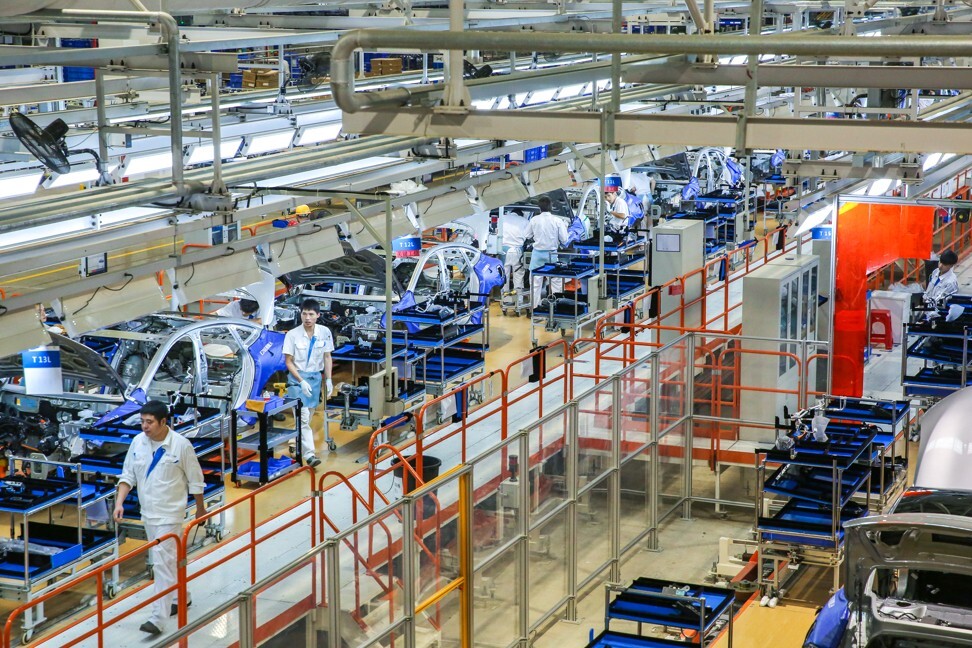
China’s US-listed electric carmakers NIO and Xpeng rev up to catch up with Tesla on their home turf as NEV battle heats up
- At NIO’s factory in the Anhui provincial capital of Hefei, 30 of the all-electric ES6 and the bigger ES8 premium SUV roll off the production line every hour, putting the carmaker on path to make 120,000 electric cars a year
- In the Guangdong provincial city of Zhaoqing, Xpeng is revving up to finish 150,000 NEVS a year at its own brand new factory
Tesla’s challengers in China are revving up their output of electric cars, as manufacturing mostly returns to normal in the first major economy to emerge from coronavirus lockdown, helping the country extend its lead in the worldwide market for new-energy vehicles (NEVs).
At NIO’s joint-venture factory in the Anhui provincial capital of Hefei, production has stepped up by 50 per cent, where 30 of the all-electric ES6 five-seat sports utility vehicle (SUV) and the bigger ES8 premium SUV roll off the production line every hour, putting the carmaker on path to make 120,000 electric cars a year. Further south in the Guangdong provincial city of Zhaoqing, Xpeng is revving up to finish 150,000 NEVS a year at its own brand new factory.
NIO and Xpeng are two of the three US-listed Chinese NEV makers hot on the heels of the industry leader Tesla in a market where sales could more than double to 3 million units a year by 2025. NIO’s November sales more than doubled to 5,291 cars from last year, while Xpeng’s more than quadrupled to 4,224 cars. Tesla, which delivered 12,785 Model 3 cars in October made at its Gigafactory 3 in Shanghai, is yet to unveil its November sales data.
“As the volume of orders becomes bigger and bigger, we will able to increase our production,” said Victor Gu, general manager of NIO’s Advanced Manufacturing Centre, during a recent visit to the factory in Hefei. “Our plant has become [an internet celebrity] because of the high degree of automation and best technology used, which attracted a lot of visits by government officials and industry executives.”

Built in 2016 with its partner JAC Motors, NIO’s Hefei plant covers 560,000 square metres (7.18 million sq ft) and employs 2,000 workers and 200 engineers. The highly automated factory uses 307 robots to assemble the ES6 and ES8. The seven-seat ES8 flagship, which sells from 407,500 yuan (US$62,389) after subsidy, has the highest usage of aluminium among all cars produced worldwide, NIO said.
“In the future, of course, we hope to produce more than that depending on market demand,” said Xpeng’s vice-president Jiang Ping during a recent tour of the carmaker’s factory in Zhaoqing. Jiang joined Xpeng from NIO, where he was a vice-president in manufacturing and operations, to be closer to his family in southern China.

The battle for supremacy in China’s new-energy vehicle market began in earnest after Tesla started domestic production of its bestselling Model 3 car in December 2019. In October, Tesla cut the starting price of the Model 3 by 8 per cent to 249,900 yuan, ratcheting up pressure on its Chinese rivals.
NIO, Xpeng and Li Auto have continued to post increasing sales thanks to government incentives encouraging the use of green cars.
The use of NEVs could accelerate in the coming years, accounting for 20 per cent of the market by 2025 from less than 5 per cent last year, Nick Lai, a JPMorgan analyst said in a research note on Wednesday.
NIO is geared to meet any increase in future demand for its cars, said Gu, who joined the start-up in 2016 from Volvo Cars where he had previously been the director of manufacturing engineering.
“Production will no longer be a bottleneck for NIO’s future growth,” he said.
Xpeng said its production capacity will further jump in 2023 when its second fully-owned production base in Guangzhou is expected to start production.
“Investors have priced in their optimism about the start-ups’ growth potential, but they need to display their production and marketing capabilities to prove their fundamentals can support the elevated prices,” said Gao Shen, an independent analyst covering manufacturing in Shanghai.
“In 2021, the companies are supposed to present improved performance to justify their frothy market values.”


